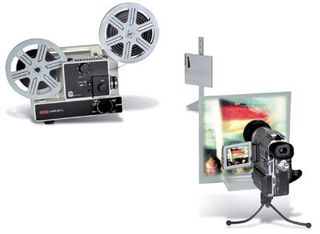Workshop: A Digital Facelift for Your Analog Movies
Hot Spots
The Super-8 projector lamp often creates bright, round areas on the surface of the screen, also known as hot spots. Also, the video is frequently grainy. You can deal with both problems by placing a large panel of plastic (available in specialty stores) in front of the projector screen. But you won't be able to improve the video quality much unless you make use of a glass screen like the one offered by Video Optik Brähler. This glass projection screen is non-granulated and contains an embedded waxy layer of paraffin in the glass pane to reduce the hot spots.
If you're more adventurous, you can create your own alternative screen. Just set up a screen template in Photoshop (or another graphics program) made out of several sheets; in the middle, place a radial gray wedge that gradually fades away as it approaches the end. This gray wedge also reduces hot spots. If that still doesn't fix the problem, Virtual Dub can save the day with a hot spot filter that darkens the center of your image in the shape of a circle, while its radial luminance filter brightens the edge of the screen.
Eliminating Flickering
If the Super-8 films you recorded with the DV camcorder already flicker in the camera display, the trouble lies in not having synchronized the frame frequencies of the projector and camera; camcorder movies run at 50 images per second, while Super-8 projectors only manage between 18 and 24 images per second. So if you want to eliminate flickering, you'll have to establish a whole-numbered ratio between the projector and the DV-camcorder frames: projector frame frequencies of 16 2/3 (three-blade shutter) or 25 (two-blade shutter) provide ideal ratios of 1:3 or 1:2, respectively.
If you can't set the projector to these frequencies exactly, you should try to at least get as close as possible. Unfortunately, you'll still see some flickering on your DV-camcorder monitor at 16 and 24 images per second for both three-blade and two-blade shutters. Also, the video will be somewhat darker because of the shutter, but this is generally not a serious issue.
If the projector doesn't allow you to play films at 25 or 16 2/3 images per second, you can also try manually changing the running speed of the projector with a socket dimmer.
If, after all these steps, you still haven't been able to get rid of that annoying flickering, you can turn to Virtual Dub for help again. The program has a deflicker filter to even out the differences in contrast between the individual images and effectively eliminate flickering.
Stay on the Cutting Edge
Join the experts who read Tom's Hardware for the inside track on enthusiast PC tech news — and have for over 25 years. We'll send breaking news and in-depth reviews of CPUs, GPUs, AI, maker hardware and more straight to your inbox.

Special screens are perfect for recording Super-8 movies with a DV camcorder without hurting the quality much. The image shows a Super-8 film being back-projected onto a glass screen.
Current page: Hot Spots
Prev Page HDD Standard Not Important Next Page Recording And Restoring MoviesMost Popular

